By Frank Iannamico
During WWII there was an overwhelming demand for the Thompson Submachine Gun, to supply both U.S. and Allied armies. In 1939, Savage Arms was contracted by Auto-Ordnance to manufacture the weapon. Due to the complex construction of the Thompson, Savage had a difficult time keeping up with the ever-increasing demand. As a result, the Auto-Ordnance Corporation opened their own factory in 1941 to help fill the Ordnance Department’s requirements for the weapon.
The 1928A1 Thompson Submachine Guns being produced at Auto-Ordnance’s Bridgeport plant were identical mechanically and in appearance to those being made by Savage in Utica, New York. The letters AO preceding the weapon’s serial number on the left side of the M1928A1 model’s receiver will easily identify an M1928A1 Thompson that was produced in the Auto-Ordnance’s Bridgeport, Connecticut plant. A similar AO prefix serial number was applied to the rear of the trigger frame.
The early manufacture Auto-Ordnance, Bridgeport guns, like their Savage counterparts, were fitted with the finned barrel and the adjustable Lyman rear sight. There were many Savage and other subcontractor manufactured parts used to assemble the guns produced at the Auto-Ordnance plant. The parts that were manufactured in house by Auto-Ordnance were stamped with the letters AO or AOC.
As production continued the Auto-Ordnance Thompsons, like the Savage manufactured guns, also began to be fitted with the simple stamped fixed “L” style aperture rear sight. On the Auto-Ordnance, Bridgeport produced Thompsons the “L” style rear sight began to appear on guns at approximately the 80,000 serial number range. However, there was no defining line where the use of the Lyman adjustable sight was discontinued, as they continued to appear sporadically throughout the entire range of serial numbers.
In early production the finned barrel was still fitted on the Auto-Ordnance, Bridgeport guns, but was eventually replaced by the easier to manufacture, smooth barrel that began to appear at the 85,000 serial number range. As with the rear sights there was no defining line on the type of barrel that was installed on any particular serial number range on Auto-Ordnance Thompsons. Even after the smooth barrels began to be fitted, the finned style barrels continued to sporadically appear through the entire serial number range until the end of production.

Note; while the “L” sight and smooth barrel began to appear on mid-range serial number Savage 1928’s they appeared on lower numbered Auto-Ordnance, Bridgeport guns. The reason is that the Savage factory began manufacturing the guns approximately eighteen months before Auto-Ordnance. Thus, a low numbered Auto-Ordnance 1928 model was manufactured at the same time period a mid-range number Savage gun.
The Cutts compensator was retained on all military A-O 1928A1 models throughout production. Most of the Auto-Ordnance, Bridgeport Thompsons were fitted with the late (4th) style compensator that has the Thompson bullet logo on the left side, and the Auto-Ordnance name roll marked across the top of the leading edge. All M1928A1 model Thompsons made at the Auto-Ordnance, Bridgeport plant were originally fitted with the horizontal style foregrips.
The Auto-Ordnance, Bridgeport plant was under the jurisdiction of the Springfield Ordnance District in 1941. Thompson Guns were inspected and proofed by on site Springfield ordnance inspectors. The initials of the chief executive officer of the respective Ordnance Districts, who were designated as Army Inspectors of Ordnance or AIOs, were stamped on the guns indicating that they accepted the weapons on behalf of the United States Government. Springfield District Chief executive officers during WWII Thompson production were; Waldemar Broberg and Lt. Colonel Guy H. Drewery. Subordinate ordnance officers managed the inspection process, and all of the guns were actually inspected and stamped by personnel working under their respective chief inspectors. The purpose of the government inspection was to insure that the material being manufactured was the type, quality and quantity specified in the government agreement with the provider. Great emphasis was placed on government contractors to perform their own quality inspections at their factories to avoid having material rejected by the government inspectors. This was done to avoid delays in badly needed materials and to avoid the expense of rejected goods. The quality fit and finish of the Auto-Ordnance produced guns was identical to those of Savage manufacture. Interchangeability of parts was 100% as per Ordnance Department directives.
Model of M1928A1 parts manufactured by Auto-Ordnance’s factories or subcontractors and marked AOC were; Receivers, trigger frames, Blish locks, bolts, actuators, barrels, grip mounts, butt plates, sears, sear levers, trip levers, disconnectors, safety levers and pivot plates.
Although the Remington Arms Company was subcontracted to manufacture many Thompson parts for Auto-Ordnance, in January of 1942, Auto-Ordnance acquired the machinery from Remington and moved it into their Bridgeport plant and began manufacturing the parts themselves. These parts included the actuator, bolt, extractor, ejector and disconnector.
An interesting variation of the Auto-Ordnance, Bridgeport produced M1928A1 Thompson that has been observed, are those Thompsons that have had the U.S. designation ground off and the A1 mark overstamped to read AC. Many of the guns documented had been refurbished, and fitted with the smooth barrels and the “L” style fixed rear sight. Many, but certainly not all, of these guns so altered were in the 150,000 to 152,000 serial number range. A letter X was added as a suffix on the serial numbers of many of these guns. A few other examples of these “1928AC” Thompsons documented were fitted with the finned barrel and Lyman adjustable rear sight. A small number of these Thompsons had their original military horizontal foregrip replaced with the early style vertical foregrip. It is believed that these were guns that had been purchased from the government by the Auto-Ordnance Corporation and refurbished in order to be sold to law enforcement agencies after they were surplused. The Numrich Arms Corporation also removed U.S. markings from 1928 and 1928A1 model Thompsons they sold in the 1950’s.
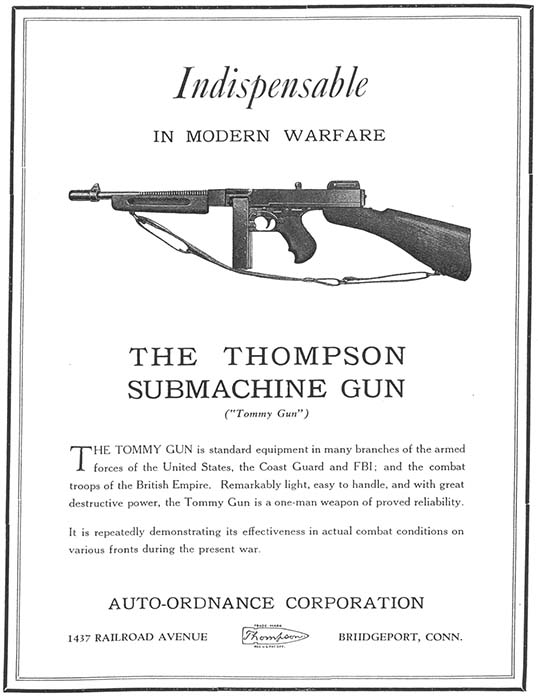
Interestingly, some of the AO “1928AC” overstamped Thompsons did not have Army Inspector of Ordnance (AIO) acceptance stamps on them, but were stamped with the Ordnance “wheel” acceptance mark. While other examples of these guns had no government inspector or acceptance stamps at all, suggesting that they were never inspected or accepted by the U.S. Government. Perhaps these guns were contract overruns or assembled from parts that remained after the government contracts were filled. However, no documentation could be located that could prove or disprove this theory.
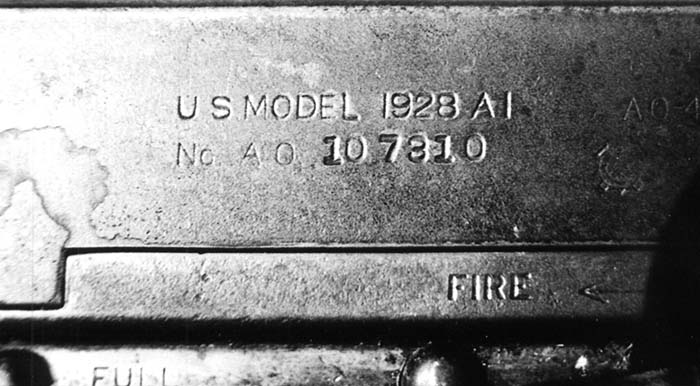
A Treasury Department IRS Form dated June 30, 1944 reveals that two Auto-Ordnance manufacture U.S. 1928A1 Thompsons with an X suffix added to the serial numbers were sold to a Massachusetts police department that year. The U.S. was ground off and the letter C over stamped on the 1 on both of the guns. Please note that the war didn’t end until the 15th of August 1945. All of the 1928 “AC” guns documented were originally manufactured by the Auto-Ordnance Corporation’s Bridgeport factory, and in almost every case had an AO prefixed serial numbered frame, although most of the frame/receiver numbers were mis-matched. The serial numbers located on the frames of these weapons also had the letter X added to them.
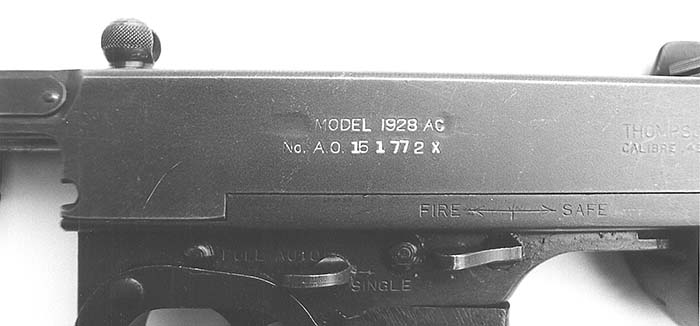
Although most of the Bridgeport manufactured Thompsons documented had the very common mismatched receiver and frame numbers, I found it interesting that in almost every case of an Auto-Ordnance, Bridgeport mismatched gun, the frames were also of Auto-Ordnance manufacture. Even though the Savage frames are completely interchangeable, few Auto-Ordnance, Bridgeport guns were observed with Savage trigger frames. The only two serialized parts on wartime Thompsons were the receiver and the trigger frame. The only reason for this was that when the Thompsons were manufactured the lower frames and receivers were hand fitted to each other to insure a close fit between the two parts. It was purely for cosmetic purposes, and had no bearing on the reliability or functioning of the weapon.
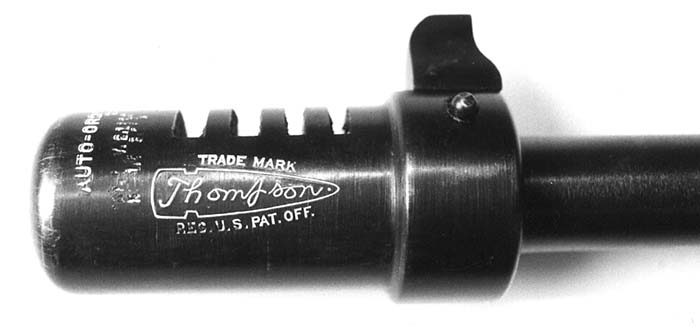
As per standard Ordnance Department procedures when there was more than one contractor manufacturing the same weapon, there were separate blocks of serial numbers assigned to each contractor. This was done so that no two weapons would be produced with the same serial number. However, during the military run there were some numbers duplicated, and a few more that were only one or two numbers different, the only difference being the letter S or AO preceding the serial number. Even though there were serial numbers that were close or duplicated on Savage and Auto-Ordnance guns, the dates that those Thompsons had actually been manufactured were quite different. By the time Auto-Ordnance, Bridgeport had produced their very first M1928A1 gun, Savage had shipped well over 200,000 1928 and M1928A1 model Thompsons.
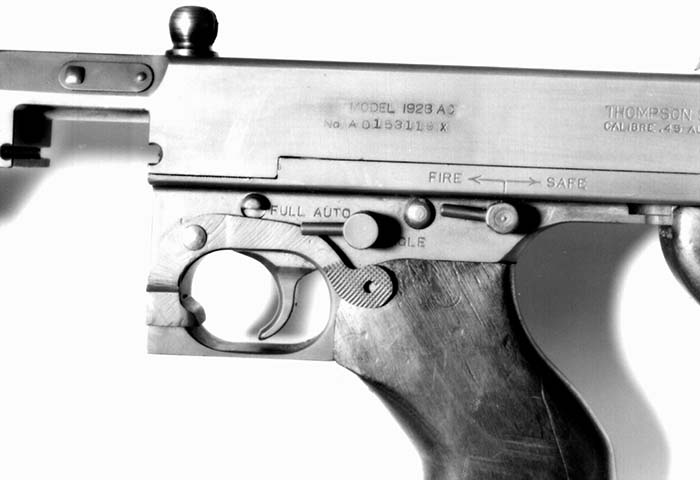
(Courtesy David Tengdin, photo by Tim Fahs)
Other major variations of the Auto-Ordnance, Bridgeport manufactured gun were the same as the Savage models.
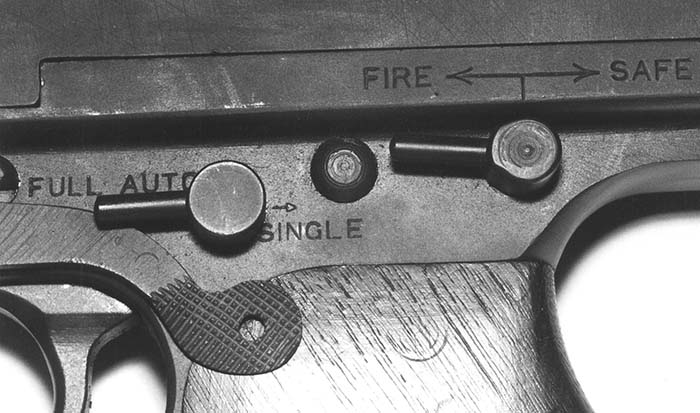
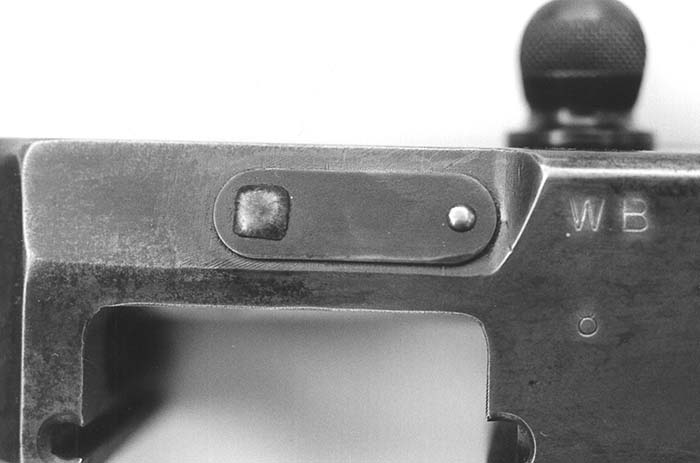
Finned barrel, Lyman adjustable rear sight.
Finned barrel, “L” style rear aperture sight.
Smooth barrel, “L” type rear sight.
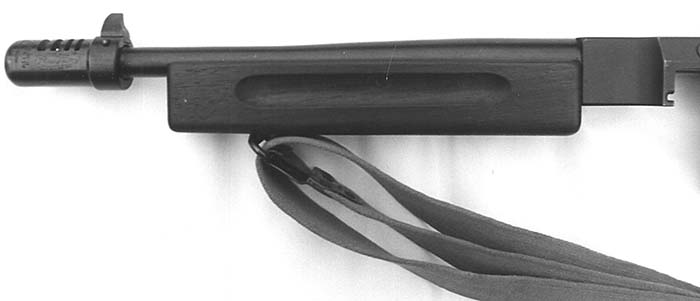
The Auto-Ordnance Corporation manufactured several experimental prototypes of the Thompson in an attempt to get more life out of the original design. There were 1928 model variations chambered for the U.S. 30’06 caliber, as well as a few prototypes made chambered for .30 carbine cartridge. The rifle cartridges proved to be too powerful for the Thompson’s Blish lock delayed blow-back system.
On 25 April 1942, the M1928A1 Thompson was reclassified as “Limited Standard”. The M1928A1 weapons were to be replaced in service by the new M1 version of the Thompson and the M3 submachine gun that was under development by the Ordnance Department and the Guide Lamp Division of General Motors. Due to unforeseen problems the M1928A1 model continued to be manufactured until the autumn of 1942.
Auto-Ordnance, Bridgeport manufactured their last U.S. M1928A1 model on 15 October 1942. Thereafter they concentrated on producing the M1 and M1A1 model. Government documents show that the Bridgeport factory manufactured a total of 323,900 M1928A1 Thompsons. The grand total of 1928 and M1928A1 Thompson Submachine Guns manufactured during WWII, by both Savage and the Auto-Ordnance facilities was an estimated 1,070,832 from 1940 to the fall of 1942 when the M1928A1 model was superseded by the M1 version.
The official end of the M1928A1 model came at an Ordnance Committee meeting held on 16 March 1944 item 23248; Memorandum for the Standards and Specification Section, Conservation Branch, Production Division, Army Service Forces. It was noted for the record that; “U.S. Army specification 52-3-30 of Gun, Submachine, Thompson, Caliber .45 M1928A1 be canceled in accordance with paragraph 30, AR 850-25”. The request was approved.
This article was condensed from relative information in the book AMERICAN THUNDER: The Military Thompson Submachine Gun, available from Moose Lake Publishing LLC. 207-683-2959
| This article first appeared in Small Arms Review V5N6 (March 2002) |











